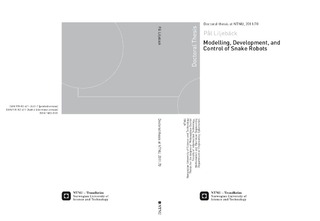| dc.contributor.author | Liljebäck, Pål | nb_NO |
| dc.date.accessioned | 2014-12-19T14:03:27Z | |
| dc.date.available | 2014-12-19T14:03:27Z | |
| dc.date.created | 2011-03-25 | nb_NO |
| dc.date.issued | 2011 | nb_NO |
| dc.identifier | 408619 | nb_NO |
| dc.identifier.isbn | 978-82-471-2668-4 (electronic) | nb_NO |
| dc.identifier.isbn | 978-82-471-2667-7 (printed) | nb_NO |
| dc.identifier.uri | http://hdl.handle.net/11250/260294 | |
| dc.description.abstract | This thesis is motivated by the long-term goal of developing snake robots which can move in unknown and challenging environments in order to support human intervention tasks. Inspired by biological snakes, snake robots typically consist of a large number of serially connected joint modules which provide stable and robust locomotion skills. The aim of this thesis is to increase our basic understanding of snake robot locomotion and to present new control strategies for these mechanisms. The thesis contains two parts.
Part I
Part I considers planar snake robot locomotion across horizontal and flat surfaces. The treatment of this control problem is based on two different mathematical models of the snake robot. The first model is developed from first principles, while the second model is developed based on simplifying assumptions.
The models are analysed using several techniques. A stabilizability and controllability analysis reveals fundamental properties of snake robot dynamics which have been assumed in the snake robot literature, but never formally proven. Several properties are also derived directly from the equations of motion of the robot, some of which explain why anisotropic ground friction properties are important during .at surface locomotion. An averaging analysis reveals important relationships between specific gait pattern parameters of the robot and the resulting velocity during locomotion.
Two controllers for straight line path following control are proposed. By analysing a Poincaré map, all state variables of a snake robot, except for the position along the desired straight path, are shown to trace out an exponentially stable periodic orbit with the .rst controller. Using cascaded systems theory, the second controller is proved to κ-exponentially stabilize a snake robot to any desired straight path under the assumption that the forward velocity is contained in some nonzero and positive interval. Mor over, a waypoint guidance strategy is proposed for steering a snake robot along more general paths de.ned by waypoints interconnected by straight lines. The guidance strategy is guaranteed to steer the position of the robot into the acceptance region of each waypoint. Furthermore, it is outlined how the controllers can be extended to path following of general curved paths.
The development of a snake robot for .at surface motion is presented, and the robot is employed to experimentally validate many of the theoretical results.
Part II
Part II considers snake robot locomotion in environments containing external objects (or obstacles), which is in line with practical applications of these mechanisms. A hybrid model of a planar snake robot interacting with obstacles is presented, where obstacle interaction is modelled by introducing a unilateral velocity constraint on each contacted link of the robot. The existence and uniqueness properties of the hybrid model are investigated based on the theory of linear complementarity problems.
The control problem in this obstacle environment is attacked based on the notion of obstacle-aided locomotion, where the snake robot is propelled by active use of the contact forces from the obstacles. A general control principle is proposed which suggests that obstacle-aided locomotion is achieved by producing body shape changes where the links in contact with obstacles are rotated to increase the propulsive forces on the robot. This control principle is employed to propose a hybrid controller aimed at resolving situations where the snake robot is jammed between obstacles. The control principle is also instrumental in the development of a straight line path following controller in the obstacle environment, where the motion of the snake robot is speci.ed in terms of a body wave component, an environment adaptation component, and a heading control component.
The development of a snake robot for motion in unstructured environments is presented. The robot, which can sense its environment due to a novel force sensing system, is employed to experimentally investigate the proposed control strategies.
| nb_NO |
| dc.language | eng | nb_NO |
| dc.publisher | Norges teknisk-naturvitenskapelige universitet, Fakultet for informasjonsteknologi, matematikk og elektroteknikk, Institutt for teknisk kybernetikk | nb_NO |
| dc.relation.ispartofseries | Doktoravhandlinger ved NTNU, 1503-8181; 2011:70 | nb_NO |
| dc.title | Modelling, Development, and Control of Snake Robots | nb_NO |
| dc.type | Doctoral thesis | nb_NO |
| dc.contributor.department | Norges teknisk-naturvitenskapelige universitet, Fakultet for informasjonsteknologi, matematikk og elektroteknikk, Institutt for teknisk kybernetikk | nb_NO |
| dc.description.degree | PhD i Teknisk kybernetikk | nb_NO |
| dc.description.degree | PhD in Engineering Cybernetics | en_GB |

